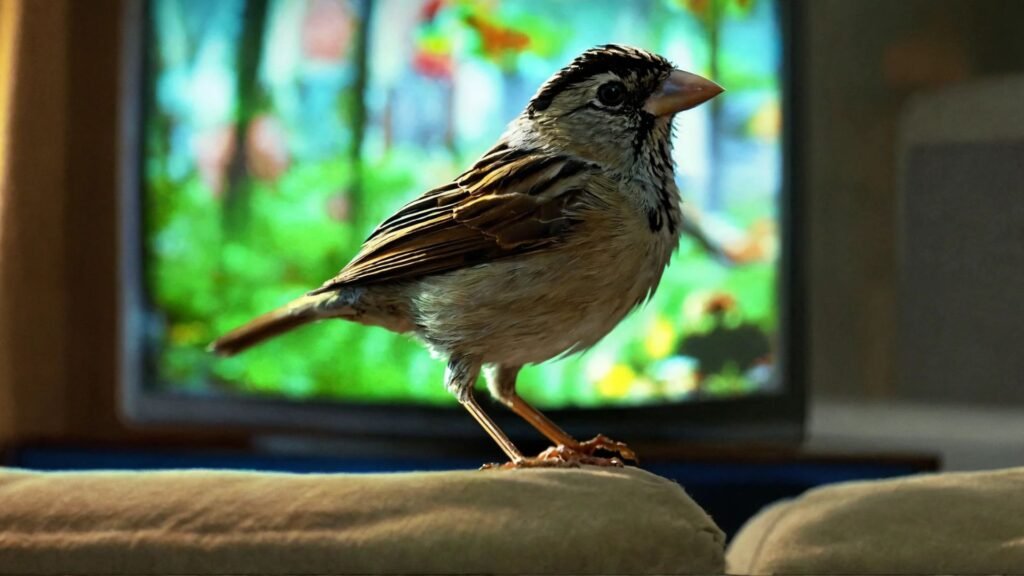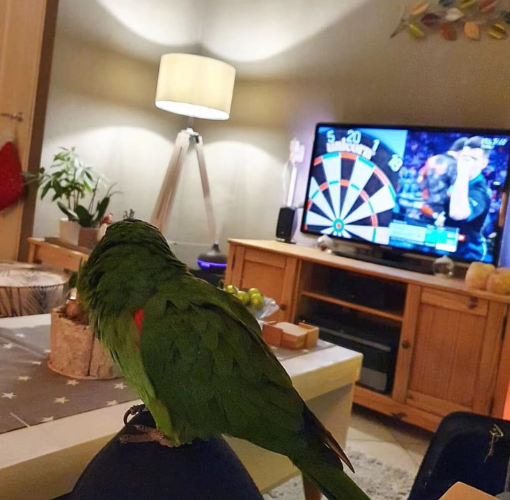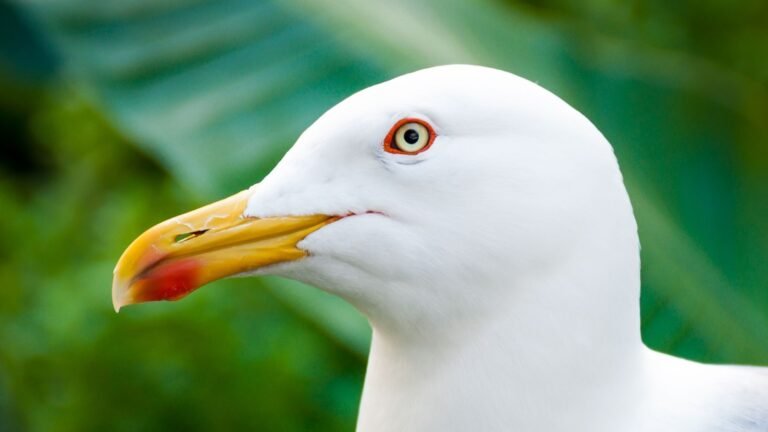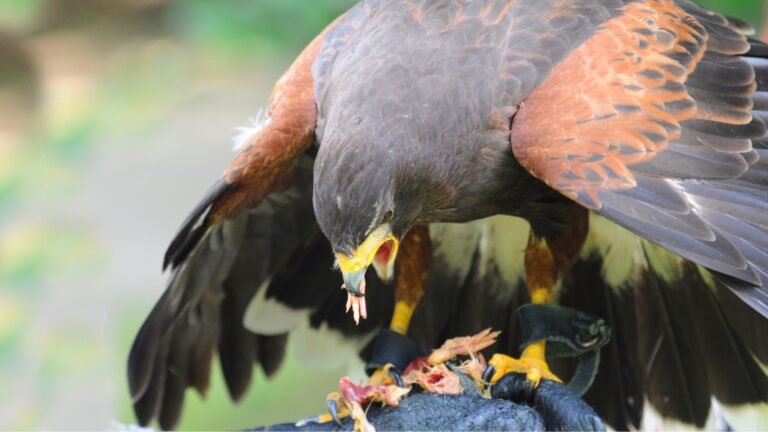Can Birds Watch TV?

Birds are remarkable creatures with extraordinary visual abilities. From raptors like eagles and hawks to small songbirds, their keen eyesight is essential for survival. But can these feathered friends actually perceive and comprehend what they see on a television screen? Well, the answer is “Yes”, birds can indeed watch TV. In this article we will discuss everything you need to know about birds vision specially in relation to watching TV.
Key Takeaways
• Birds do can watch and perceive television screens, thanks to their extraordinary visual abilities.
• Watching TV can provide enrichment and mental stimulation for pet birds, especially videos of other birds engaging in natural behaviors.
• Larger, more intelligent bird species tend to be more engaged viewers compared to smaller birds.
• TV viewing should be done in moderation and not replace other forms of enrichment and physical activity.
• Birds can perceive depth and movement on flat TV screens due to their high temporal resolution and ability to process visual cues.
Birds Watching TV
Okay, first things first, can birds actually watch TV? The answer is a resounding yes! Just like us humans, our avian friends can perceive and comprehend what’s happening on the screen. However, their experience might be a bit different from ours due to their unique visual adaptations.
However, as with anything in life, moderation is key. Excessive screen time can be a concern for any creature, feathered or not. If birds were exposed to an excessive amount of TV viewing from which they couldn’t opt out, that would likely be unhealthy, just as it can be for us humans.
For instance, if a bird appears “entranced” while staring at the screen, it simply means they’re engrossed and focused on what they’re watching. For birds inclined to do this, it’s important to observe limits on their screen time through moderation.
But why can birds watch TV in the first place?
Well, it all boils down to their incredible eyesight. Birds have evolved to have acute vision and color perception that far surpasses our human capabilities. They possess several adaptations that enhance their visual acuity, such as:
- Two foveas (high-density areas in the retina) for binocular vision, allowing them to focus on objects both in front and to the side simultaneously.
- A higher concentration of photoreceptors called cones, enabling them to perceive a wider range of colors, including ultraviolet wavelengths that are invisible to us humans. Isn’t that amazing? It’s like they have superpowers when it comes to vision!
Overall, the benefits of allowing birds to watch TV can outweigh the risks, as long as it’s done in moderation and balanced with other enrichment activities.
You may also like: 6 Birdhouses To Attract Different Birds
Perceiving Depth and Movement on TV

One crucial aspect of watching TV is the ability to perceive depth and movement on a flat screen. Birds excel in this regard due to their high temporal resolution, allowing them to detect rapid movements that would appear as a blur to human eyes. For instance, while humans can only perceive movements up to 50 cycles per second, some birds like budgerigars and chickens can detect over 100 cycles per second!
Apart from that, birds also have excellent depth perception, thanks to their binocular vision and the ability to process various visual cues like motion parallax, occlusion, and stereopsis. This skill is essential for activities like catching prey or navigating through cluttered environments.
Now, you might be wondering, can birds actually recognize and understand the objects and scenes displayed on TV?
Birds Recognizing Objects and Scenes on TV
Well, according to some studies, birds have remarkable visual cognition abilities that allow them to form visual categories and concepts. They can even learn from watching videos of other birds’ reactions, a process known as social learning.
For example, in one experiment, blue tits and great tits learned to avoid unpalatable prey by observing videos of other birds’ responses. Isn’t that incredible? It’s like they’re taking notes from their feathered friends on what’s safe to eat and what’s not.
However, it’s important to note that a bird’s ability to recognize objects on TV may depend on factors like the resolution, brightness, and contrast of the display, as well as the bird’s familiarity with the depicted objects or scenes. Just like us, they might have a harder time recognizing things that are unfamiliar or presented out of context.
Now, let’s talk about the possible benefits of allowing birds to watch TV.
Benefit Of Watching TV On Birds
Many bird owners have found that playing videos designed for birds can provide enrichment and mental stimulation. Videos of other birds eating, singing, or engaging in natural behaviors can be fascinating for pet birds to observe. It allows them to see and hear members of their own species when they may be the only bird in the household, fulfilling some of their innate needs to be part of a flock.
However, it’s important to note that not all birds seem equally interested in watching TV or videos. Larger, more intelligent parrot species like macaws, cockatoos, and African greys tend to be more engaged viewers compared to smaller birds like canaries or finches.
In addition to enrichment, some experts recommend playing videos of birds vocalizing to help teach appropriate vocalizations to pet birds, especially handfed babies who may not learn natural calls from parents. The sounds and visuals can be imprinted on the young birds.
That said, TV viewing should only supplement, not replace, other enrichment activities like foraging toys, climbing structures, and direct interaction with owners. Too much passive TV watching could potentially lead to obesity or problematic behaviors in some birds if they become sedentary.
Challenges and Limitations of Birds Watching TV
While birds possess remarkable visual abilities, there are certain challenges and limitations to consider when it comes to watching TV:
- Screen Resolution: The resolution of most consumer TVs may not be high enough to fully capture the intricate details that birds can perceive, potentially limiting their ability to recognize objects or scenes accurately.
- Flicker Fusion: Some birds may perceive the flickering of certain displays, which could be distracting or even uncomfortable for them.
- Contrast and Brightness: Birds may have difficulty perceiving images on screens with poor contrast or brightness levels, as their visual systems are adapted to different light conditions.
- Familiarity and Context: Birds may struggle to recognize objects or scenes that are unfamiliar or presented out of context, as their visual perception is closely tied to their natural environments and experiences.
Okay. Now that we know that birds can actually watching TV you may be wondering, “what kind of content can they watch?
What Can Birds Watch On TV?
In the same way we select suitable content for our children and ourself, we should also do the same for our birds. The content also matters – birds are more likely to pay attention to videos of their own or similar species rather than just random nature footage.
Here are some general recommendations for TV content that birds may enjoy:
Nature Documentaries and Shows
Shows featuring birds, animals, and natural environments can be highly engaging and educational for pet birds.
Examples: Planet Earth, Nature, Spy in the Wild, etc.
Bird-Specific Content
Videos specifically made for birds, featuring other birds, can be entertaining and help mimic their natural social interactions.
Examples: BirdTricks channel on YouTube, Parrot Wizard, etc.
Animated Movies and Shows
Colorful animations with dynamic visuals and sounds can capture a bird’s attention and provide mental stimulation.
Examples: Rio, Pixar movies, nature-themed cartoons, etc.
When first introducing your bird to watching TV, you should try to do it gradually. Try to monitor your bird’s reaction to ensure they are not stressed or overstimulated. Provide a variety of content to prevent boredom and maintain their interest. Limit screen time to a few hours per day and ensure your bird has plenty of other enrichment activities. Avoid content with predatory birds or animals that could cause fear or distress.
Chirpping conclusion
In conclusion, while the idea of birds watching TV may seem anthropomorphic, research suggests that their remarkable visual abilities and cognitive skills allow them to perceive and potentially comprehend certain aspects of on-screen content. However, their ability to fully engage with and understand television programs is still an area of ongoing investigation.
As with any media for humans or animals, moderation is key. Short, supervised TV sessions can be an enjoyable bonding experience for birds and owners, but should be balanced with plenty of physical exercise, mental challenges, and quality time together away from screens.
You may aslo like: Can Birds Hear?
Questions & Answers
Q: Is it safe for birds to watch TV?
A: Yes, it is generally safe for birds to watch TV in moderation, just as it is for humans. Excessive screen time without breaks should be avoided.
Q: Which bird species are more likely to be interested in watching TV?
A: Larger, more intelligent bird species like macaws, cockatoos, and African greys tend to be more engaged viewers compared to smaller birds.
Q: Can birds learn from watching videos of other birds?
A: Yes, studies have shown that birds can learn from observing videos of other birds’ reactions, a process known as social learning.
Q: Do birds perceive depth and movement on TV screens differently than humans?
A: Yes, birds have higher temporal resolution and can detect rapid movements that appear as a blur to humans. They also have excellent depth perception due to binocular vision and processing visual cues.
Q: Can birds recognize objects and scenes on TV?
A: While it depends on factors like resolution and familiarity, studies suggest birds can recognize objects and scenes on TV and form visual categories.
Q: What are some challenges birds face when watching TV?
A: Challenges include limitations in screen resolution, flicker fusion, contrast/brightness levels, and recognizing unfamiliar objects or scenes out of context.






